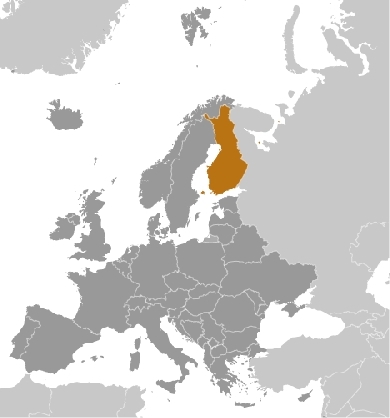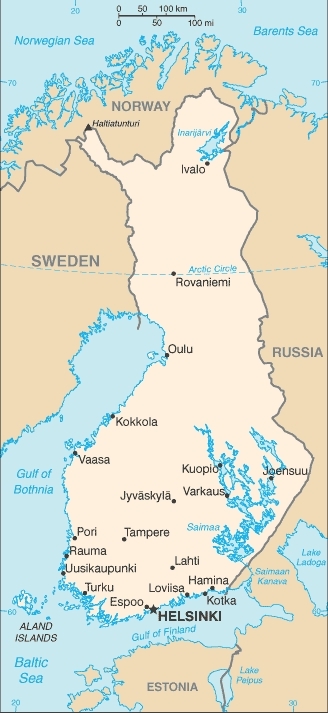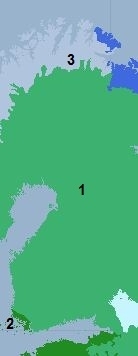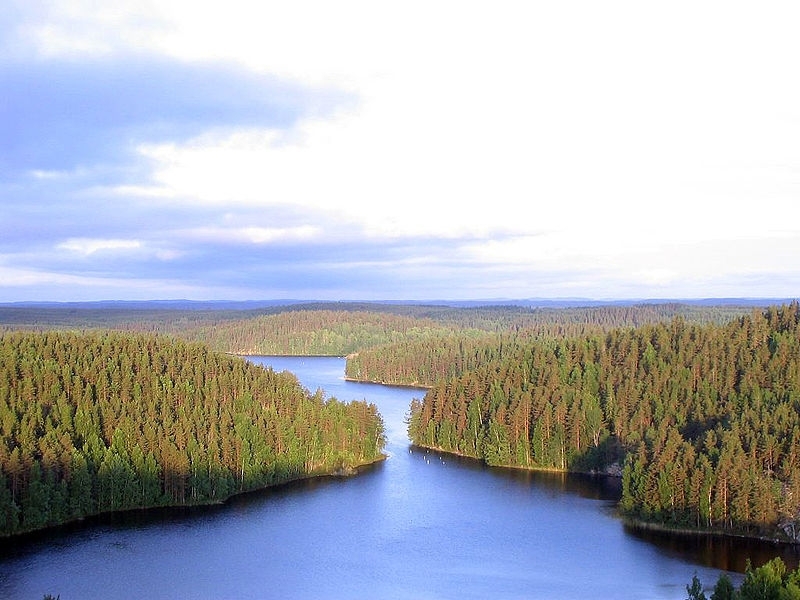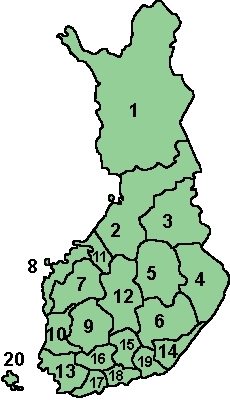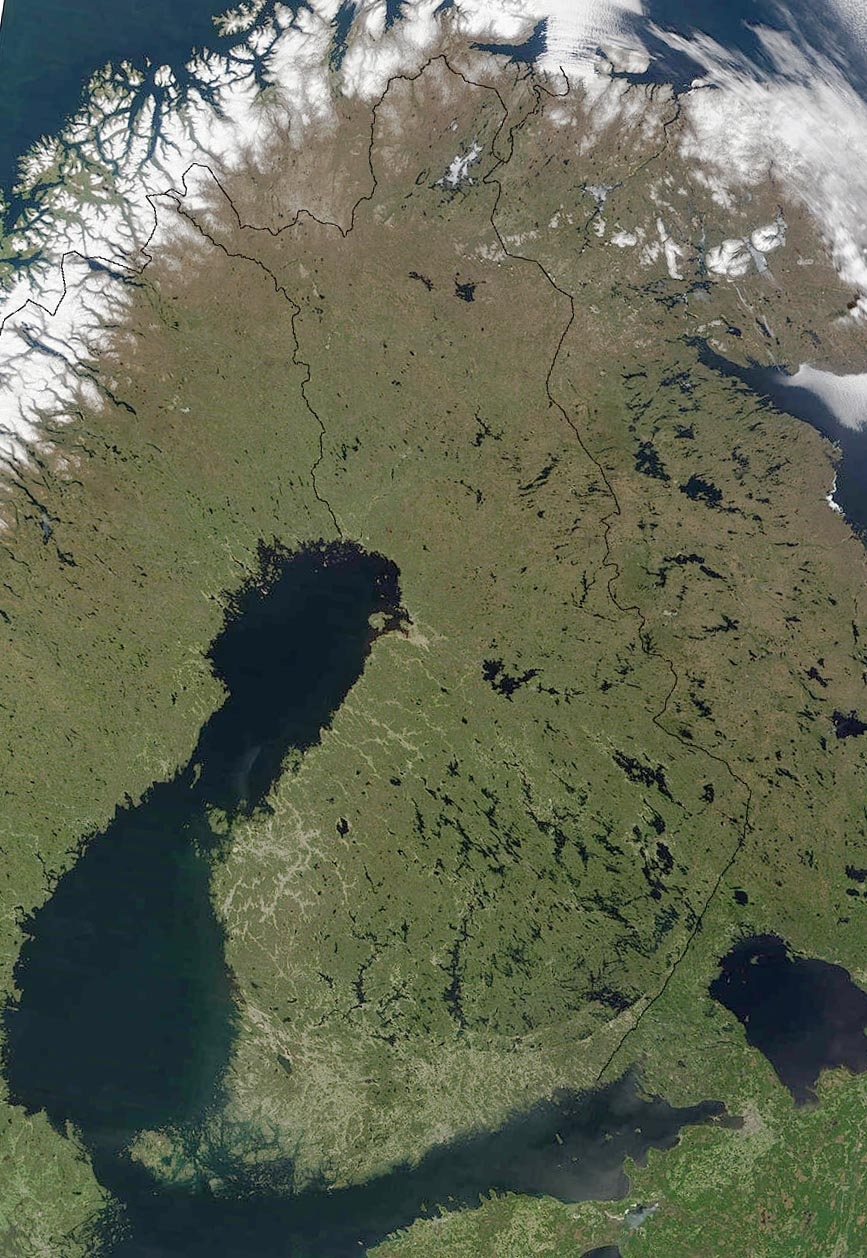Finland
Countries and Regions of the World Collection  Finland is a nation of five-and-a-quarter million people in Northern Europe, bordering the Baltic Sea, Gulf of Bothnia, and Gulf of Finland, between Sweden and Russia.
Finland is a nation of five-and-a-quarter million people in Northern Europe, bordering the Baltic Sea, Gulf of Bothnia, and Gulf of Finland, between Sweden and Russia.
The population is concentrated on a small southwestern coastal plain; a region that includes Helsinki, the northernmost national capital on European continent.
Its major environmental issues include:
- air pollution from manufacturing and power plants contributing to acid rain;
- water pollution from industrial wastes, agricultural chemicals;
- habitat loss threatens wildlife populations
Finland was a province and then a grand duchy under Sweden from the 12th to the 19th centuries, and an autonomous grand duchy of Russia after 1809.
It won its complete independence in 1917.
During World War II, it was able to successfully defend its freedom and resist invasions by the Soviet Union - albeit with some loss of territory. Finland now has a long boundary with Russia. Various groups in Finland advocate restoration of Karelia and other areas ceded to the Soviet Union, but the Finnish Government asserts no territorial demands.
In the subsequent half century, the Finns made a remarkable transformation from a farm/forest economy to a diversified modern industrial economy; per capita income is now among the highest in Western Europe.
A member of the European Union since 1995, Finland was the only Nordic state to join the euro system at its initiation in January 1999.
In the 21st century, the key features of Finland's modern welfare state are a high standard of education, equality promotion, and national social security system - currently challenged by an aging population and the fluctuations of an export-driven economy.
Contents
Geography
Location: Northern Europe, bordering the Baltic Sea, Gulf of Bothnia, and Gulf of Finland, between Sweden and Russia
Geographic Coordinates: 64 00 N, 26 00 E
Area: 338,145 sq km (land: 303,815 sq km; water: 34,330 sq km)
Land Boundaries: 2,654 km (Norway 727 km, Sweden 614 km, Russia 1,313 km)
Coastline: 1,250 km
Maritime Claims:
territorial sea: 12 nm (in the Gulf of Finland - 3 nm)
contiguous zone: 24 nm
exclusive fishing zone: 12 nm; extends to continental shelf boundary with Sweden
continental shelf: 200 m depth or to the depth of exploitation
Terrain: mostly low, flat to rolling plains interspersed with lakes and low hills. The highest point is Halti (alternatively Haltia, Haltitunturi, Haltiatunturi) (1,328 m).
Climate: cold temperate; potentially subarctic but comparatively mild because of moderating influence of the North Atlantic Current, Baltic Sea, and more than 60,000 lakes
Ecology and Biodiversity
|
1. Most of Finland is covered by Scandinavian and Russian taiga. This ecoregion spreads across a wide expanse of landscape in Scandinavia and northern Russia within the boreal forests/taiga zone. It consists of coniferous forests dominated by Scots Pine in the drier locales, frequently with an understory of Common Juniper and Norway Spruce, along with a significant admixture of White Birch and Silver Birch. 2. In the southwest there is a region of Sarmatic mixed forests. This forest type is spread over a large area of northern Europe and the Ural area of Russia; more specifically this forest type is found particularly in Scandinavia, the Baltics and the Ural area of Russia. Typically, Sarmatic mixed makes a transition into boreal taiga at their northern limit and mixed broadleaf forests at their southern limit. In Sweden these forests include certain areas of lowland to submontane hemiboreal and nemoral pine forests. The sarmatic mixed forests are comprised of a mixed conifer broadleaf plant association dominated by Norway Spruce and Scots Pine with some broadleaf admixture (particularly oak species in the north). 3. At the northernmost part of the country is a region of Scandinavian montane birch forests and grasslands. The ecoregion follows the Scandinavian Mountains. Some of the largest glaciers on the European mainland are located within the Scandinavian montane birch forests and grasslands ecoregion, as well as the highest peaks and the largest mountain plateau in northern Europe. The mountain chain itself creates a rainshadow. This stark ecoregion has extensive sparsely vegetated high alpine tundra areas, dominated by bare rock, skrees, snowfields and glaciers; other areas consist of low alpine tundra covered by Dwarf Birch admixed with willow of up to one metre in height; this low tundra has patches of grassland, bogs and lakes. See also: Kvarken Archipelago / High Coast, Finland and Sweden |
Repovesi National Park in midnight sun in Kouvola, Finland. Source: M. Passinen/Wikimedia Commons.
People and Society
Population: 5,262,930 (July 2012 est.)
Ethnic groups: Finn 93.4%, Swede 5.6%, Russian 0.5%, Estonian 0.3%, Roma (Gypsy) 0.1%, Sami 0.1% (2006)
Age Structure:
0-14 years: 16% (male 429,450/female 414,570)
15-64 years: 66.1% (male 1,759,059/female 1,719,173)
65 years and over: 17.8% (male 385,671/female 551,327) (2011 est.)
Population Growth Rate: 0.065% (2012 est.)
Birthrate: 10.36 births/1,000 population (2012 est.)
Death Rate: 10.33 deaths/1,000 population (July 2012 est.)
Net Migration Rate: 0.62 migrant(s)/1,000 population (2012 est.)
Life Expectancy at Birth: 79.41 years
male: 75.94 years
female: 83.02 years (2012 est.)
Total Fertility Rate: 1.73 children born/woman (2012 est.)
Languages: Finnish (official) 91.2%, Swedish (official) 5.5%, other (small Sami- and Russian-speaking minorities) 3.3% (2007)
Literacy: (age 15 and over can read and write): 100% (2000 est.)
Urbanization: 85% of total population (2010) growing at an annual rate of change of 0.6% (2010-15 est.)
History
The origins of the Finnish people are still a matter of conjecture, although many scholars argue that their original home was in what is now west-central Siberia. The Finns arrived in their present territory thousands of years ago, pushing the indigenous Lapps into the more remote northern regions. Finnish and Lappish--the language of Finland's small Lapp minority--both are Finno-Ugric languages and are in the Uralic rather than the Indo-European family.
Finland's nearly 700-year association with the Kingdom of Sweden began in 1154 with the introduction of Christianity by Sweden's King Eric. During the ensuing centuries, Finland played an important role in the political life of the Swedish-Finnish realm, and Finnish soldiers often predominated in Swedish armies. Finns also formed a significant proportion of the first "Swedish" settlers in 17th-century America.
Following Finland's incorporation into Sweden in the 12th century, Swedish became the dominant language for business and administration, although Finnish recovered its predominance after a 19th-century resurgence of Finnish nationalism. Publication in 1835 of the Finnish national epic, The Kalevala--a collection of traditional myths and legends--first stirred the nationalism that later led to Finland's independence from Russia.
In 1809, Finland was conquered by the armies of Czar Alexander I and thereafter remained an autonomous grand duchy connected with the Russian Empire until the end of 1917. On December 6, 1917, shortly after the Bolshevik Revolution in Russia, Finland declared its independence. In 1918, the country experienced a brief but bitter civil war that colored domestic politics for many years. During World War II, Finland fought the Soviet Union twice--in the Winter War of 1939-40 and again in the Continuation War of 1941-44. This was followed by the Lapland War of 1944-45, when Finland fought against the Germans as they withdrew their forces from northern Finland.
During the Continuation War (1941-1944) Finland was a co-belligerent with Germany. However, Finnish Jews were not persecuted. Of the approximately 500 Jewish refugees who arrived in Finland, eight were handed over to the Germans, for which Finland submitted an official apology in 2000. Also during the war, approximately 2,600 Soviet prisoners of war were exchanged for 2,100 Finnish prisoners of war from Germany. In 2003, the Simon Wiesenthal Center submitted an official request for a full-scale investigation by the Finnish authorities of the prisoner exchange. It was established there were about 70 Jews among the extradited prisoners. However, none was extradited as a result of ethnic background or religious belief.
Treaties signed in 1947 and 1948 with the Soviet Union included obligations and restraints on Finland vis-a-vis the U.S.S.R. as well as territorial concessions by Finland; both have been abrogated by Finland since the 1991 dissolution of the Soviet Union (see Foreign Relations).
Government
Finland has a mixed presidential/parliamentary system with executive powers divided between the president, who directs national security and foreign affairs, and the prime minister, who has primary responsibility for all other areas, including European Union (EU) issues. Under the constitution that took effect in March 2000 and was revised in 2012, the president directs foreign policy in close coordination with the prime minister, the minister for foreign affairs, and other ministers responsible for foreign relations. Constitutional changes strengthened the prime minister--who must enjoy the confidence of the Eduskunta (parliament)--at the expense of the president. Finns enjoy individual and political freedoms, and suffrage is universal at 18. The country's population is relatively ethnically homogeneous. Immigration to Finland has significantly increased over the past decade, although the foreign-born population, only 2.9% of the total population (December 2009), is still much lower than in any other EU country. Few tensions exist between the Finnish-speaking majority and the Swedish-speaking minority.
President and cabinet. Elected for a 6-year term, the president:
- Handles foreign policy, except for certain international agreements and decisions of peace or war, which must be submitted to parliament, and EU relations, which are handled by the prime minister;
- Is commander in chief of the armed forces and has wide decree and appointive powers;
- May initiate legislation, block legislation (temporarily) by pocket veto, and call extraordinary parliamentary sessions; and
- Appoints the prime minister after approval by the Eduskunta and the rest of the cabinet (Council of State) as selected by the prime minister. The Council of State is made up of the prime minister and ministers for the various departments of the central government as well as an ex officio member, the Chancellor of Justice. Ministers are not obliged to be members of the Eduskunta and need not be formally identified with any political party.
- The president may, upon proposal of the prime minister and after having heard the parliamentary groups, order parliament to be dissolved, and a new election held.
Parliament. Constitutionally, the 200-member, unicameral Eduskunta is the supreme authority in Finland. It may alter the constitution, bring about the resignation of the Council of State, and override presidential vetoes; its acts are not subject to judicial review. Legislation may be initiated by the president, the Council of State, or one of the Eduskunta members.
The Eduskunta is elected on the basis of proportional representation. All persons 18 or older, except military personnel on active duty and a few high judicial officials, are eligible for election. The regular parliamentary term is 4 years; however, the president may dissolve the Eduskunta and order new elections at the request of the prime minister and after consulting the speaker of parliament.
Government Type: Republic
Capital: Helsinki (population: 1.107 million est. 2009)
Adminsitrative Divisions: Since January 2010, Finland has been divided into six regional state administrative agencies--namely Etela-Suomi, Ita-Suomi, Lounais-Suomi, Lansi-ja Sisa-Suomi, Pohjois-Suomi, and Lappi--plus Aland, replacing the previous division of six provinces. Finland has 20 regions; the regions are divided into 72 sub-regions, and the sub-regions are divided into 342 municipalities. Fifteen Centers for Economic Development, Transport and the Environment (ELY Centers) form part of the government’s reform project for regional administration. The tasks and services of the former employment and economic centers, regional environmental centers, road districts, and state provincial offices’ departments for transport and communications and for education and culture have been pooled in the ELY Centers. They manage the regional implementation and development tasks of the state administration, and are tasked with promoting regional competitiveness, well-being, and sustainable development, as well as curbing climate change.
The island province of Aland is located near the 60th parallel between Sweden and Finland. It enjoys local autonomy and demilitarized status by virtue of an international convention of 1921, implemented most recently by the Act on Aland Self-Government of 1951. The islands are further distinguished by the fact that they are entirely Swedish-speaking. Government is vested in the provincial council, which consists of 30 delegates elected directly by Aland's citizens.
19 regions (maakunnat, singular - maakunta (Finnish); landskapen, singular - landskapet (Swedish));
|
Independence Date: 6 December 1917 (from Russia)
Legal System: civil law system based on the Swedish model; note - the president may request the Supreme Court to review laws. Finland accepts compulsory International Court of Justice (ICJ) jurisdiction with reservations; and, accepts International Criminal Court (ICCt) jurisdiction. The judicial system is divided between courts with regular civil and criminal jurisdiction and special courts with responsibility for litigation between the public and the administrative organs of the state. Finnish law is codified. Although there is no writ of habeas corpus or bail, the maximum period of pretrial detention has been reduced to 4 days. The Finnish court system consists of local courts, regional appellate courts, a Supreme Court, and a Supreme Administrative Court.
International Environmental Agreements
Finland is party to international agreements on: Air Pollution, Air Pollution-Nitrogen Oxides, Air Pollution-Persistent Organic Pollutants, Air Pollution-Sulfur 85, Air Pollution-Sulfur 94, Air Pollution-Volatile Organic Compounds, Antarctic-Environmental Protocol, Antarctic-Marine Living Resources, Antarctic Treaty, Biodiversity, Climate Change, Climate Change-Kyoto Protocol, Desertification, Endangered Species, Environmental Modification, Hazardous Wastes, Law of the Sea, Marine Dumping, Marine Life Conservation, Ozone Layer Protection, Ship Pollution, Tropical Timber 83, Tropical Timber 94, Wetlands, and Whaling
Foreign Relations
Finland's basic foreign policy goal from the end of the Continuation War with the U.S.S.R. in 1944 until 1991 was to avoid great-power conflicts and to build mutual confidence with the Soviet Union. Although the country was culturally, socially, and politically Western, Finns realized they must live in peace with the U.S.S.R. and take no action that might be interpreted as a security threat. The dissolution of the Soviet Union in 1991 opened up dramatic new possibilities for Finland and has resulted in the Finns actively seeking greater participation in Western political and economic structures. Finland joined the European Union in 1995.
Relations 'With' the Soviet Union and 'With' Russia
The principal architect of the post-1944 foreign policy of neutrality was J.K. Paasikivi, who was President from 1946 to 1956. Urho Kekkonen, President from 1956 until 1981, further developed this policy, stressing that Finland should be an active rather than a passive neutral. This policy is now popularly known as the "Paasikivi-Kekkonen Line."
Finland and the U.S.S.R. signed a peace treaty at Paris in February 1947 limiting the size of Finland's defense forces and providing for the cession to the Soviet Union of the Petsamo area on the Arctic coast, the Karelian Isthmus in southeastern Finland, and other territory along the former eastern border. Another provision, terminated in 1956, leased the Porkkala area near Helsinki to the U.S.S.R. for use as a naval base and gave free access to this area across Finnish territory.
The 1947 treaty also called for Finland to pay to the Soviet Union reparations of 300 million gold dollars (amounting to an estimated $570 million in 1952, the year the payments ended). Although an ally of the Soviet Union in World War II, the United States was not a signatory to this treaty because it had not been at war with Finland.
In April 1948, Finland signed an Agreement of Friendship, Cooperation, and Mutual Assistance with the Soviet Union. Under this mutual assistance pact, Finland was obligated--with the aid of the Soviet Union, if necessary--to resist armed attacks by Germany or its allies against Finland or against the U.S.S.R. through Finland. At the same time, the agreement recognized Finland's desire to remain outside great-power conflicts. This agreement was renewed for 20 years in 1955, in 1970, and again in 1983 to the year 2003, although the subsequent dissolution of the Soviet Union led to the agreement's abrogation.
The Finns responded cautiously in 1990-91 to the decline of Soviet power and the U.S.S.R.'s subsequent dissolution. They unilaterally abrogated restrictions imposed by the 1947 and 1948 treaties, joined in voicing Nordic concern over the coup against Soviet leader Mikhail Gorbachev, and gave increasing unofficial encouragement to Baltic independence.
At the same time, by replacing the Soviet-Finnish mutual assistance pact with treaties on general cooperation and trade, Finns put themselves on an equal footing while retaining a friendly bilateral relationship. Finland now is boosting cross-border commercial ties and touting its potential as a commercial gateway to Russia. It has reassured Russia that it will not raise claims for Finnish territory seized by the U.S.S.R. and continues to reaffirm the importance of good bilateral relations.
Multilateral Relations
Finnish foreign policy emphasizes its participation in multilateral organizations. Finland joined the United Nations in 1955 and the EU in 1995. The country also is a member of the North Atlantic Treaty Organization's (NATO) Partnership for Peace as well as a member in the Euro-Atlantic Partnership Council. As a NATO partner, Finland had 195 military troops and 29 civil crisis management experts in Afghanistan as of January 2012, serving with a Swedish-led Provincial Reconstruction Team in the province of Mazar-e-Sharif and working to create a secure environment for reconstruction in northern Afghanistan.
Finland is well represented in the UN civil service in proportion to its population and belongs to several of its specialized and related agencies. Finnish troops have participated in UN peacekeeping activities since 1956, and the Finns continue to be one of the largest per capita contributors of peacekeepers in the world. Finland is an active participant in the Organization for Security and Cooperation in Europe (OSCE) and in early 1995 assumed the co-chairmanship of the OSCE's Minsk Group on the Nagorno-Karabakh conflict. Finland chaired the OSCE in 2008 and was part of the Chairmanship Troika in 2009.
Cooperation with the other Scandinavian countries also is important to Finland, and it has been a member of the Nordic Council since 1955. Under the council's auspices, the Nordic countries have created a common labor market and have abolished immigration controls among themselves. The council also serves to coordinate social and cultural policies of the participating countries and has promoted increased cooperation in many fields.
In addition to the organizations already mentioned, Finland became a member of the following organizations: Bank for International Settlements, 1930; International Monetary Fund, 1948; International Bank for Reconstruction and Development, 1948; General Agreement on Tariffs and Trade (GATT), 1950; International Finance Corporation, 1956; International Development Association, 1960; European Free Trade Association, 1961; Asian Development Bank, 1966; Organization for Economic Cooperation and Development, 1969; Inter-American Development Bank, 1977; African Development Bank, 1982; Multilateral Investment Guarantee Agency, 1988; the Council of Europe, 1989; European Bank for Reconstruction and Development in Central and Eastern Europe, 1991; World Trade Organization, 1995; and INTELSAT, 1999. Finland entered Stage Three of EMU (the European Monetary Union) in 1999. All the Nordic countries, including Finland, joined the Schengen area in March 2001.
Water
Total Renewable Water Resources: 110 cu km (2005)
Freshwater Withdrawal: 2.33 cu km/yr (14% domestic, 84% industrial, 3% agricultural)
Per Capita Freshwater Withdrawal: 444 cu m/yr (1999)
This MODIS image from May 29, 2002, shows Finland is in the center of the image, and it's easy to see that the south is more heavily developed than the north. In the high-resolution imagery, it is easy to locate Helsinki, about half way up the north shore of the Gulf of Finland. To the east (right) is the beginning of the Russian Federation. Source: NASA. Credit: Jacques Descloitres, MODIS Land Rapid Response Team, NASA/GSFC
Agriculture
Agricultural products: barley, wheat, sugar beets, potatoes; dairy cattle; fish
Irrigated Land: 770 sq km (2008)
Resources
Natural Resources: timber, iron ore, copper, lead, zinc, chromite, nickel, gold, silver, limestone
Land Use:
arable land: 6.54%
permanent crops: 0.02%
other: 93.44% (2005)
Economy
Finland has a highly industrialized, free-market economy with a per capita output equal to that of other western economies such as France, Germany, Sweden, or the U.K. The largest sector of the economy is services (57.1%), followed by manufacturing and refining (40.3%). Primary production is at 2.6%.
The Finnish economy had made enormous strides since the severe recession of the early 1990s. Finland successfully joined the euro zone and outperformed euro-area partners in terms of economic growth and public finance. Following a period of sustained and robust growth, the Finnish economy suddenly slowed in the wake of the international financial crisis. GDP growth shrank from 0.9% in 2008 to -8.2% in 2009 (the sharpest contraction since Finland gained independence from Russia in 1917). Exports declined 32%, and unemployment climbed to 8.2%.
In 2010 the Finnish economy recovered from the 2009 financial crisis better than most forecasts predicted, and showed a broad-based growth of 3.1%. The European financial crisis negatively affected Finnish exports and contributed to lower than expected growth of 2.9% in 2011. In 2012 Finland should avoid recession, but growth is expected to be minimal, predicted at 0.4%. The unemployment rate for 2011 was 7.8%. Inflation rose to 3.6% in 2011.
The general government financial balance turned to deficit in 2009, bringing an end to a sustained period of surpluses. Nonetheless the deficit did not exceed the 3% threshold under the EU Stability and Growth Pact. Despite significant budget cuts and increased taxes, the current budget predicts a deficit of -1.4% in 2012.
Exports of goods and services contribute over 38% of Finland's GDP. Metals and engineering (including electronics) and timber (including pulp and paper) are Finland's main industries. The United States is Finland's third most important trading partner outside of Europe. With a 3.7% share of imports in 2011, the United States was Finland's sixth-largest supplier. Major exports from the United States to Finland continue to be machinery, telecommunications equipment and parts, metalliferous ores, road vehicles and transport equipment, computers, peripherals and software, electronic components, chemicals, medical equipment, and some agricultural products. The primary competition for American companies comes from Russia, Germany, Sweden, and China. The main export items from Finland to the United States are electronics, machinery, ships and boats, paper and paperboard, refined petroleum products, telecommunications equipment and parts. In 2011, the United States was Finland's largest customer after the EU (55.0%), and Russia (9.4%). However, trade is only part of the totality: American companies in Finland employed 23,800 Finns, and Finnish companies in America employed 31,500 Americans in 2008. About 2.0% of the Finnish GDP comes from exports to the United States.
Except for timber and several minerals, Finland depends on imported raw materials, energy, and some components for its manufactured products. Farms tend to be small, but farmers own sizable timber stands that are harvested for supplementary income in winter. The country's main agricultural products are dairy, meat, and grains. Finland's EU accession has accelerated the process of restructuring and downsizing of this sector.
Finland is strongly competitive in manufacturing - principally the wood, metals, engineering, telecommunications, and electronics industries. Finland excels in high-tech exports such as mobile phones.
Because of the climate, agricultural development is limited to maintaining self-sufficiency in basic products. Forestry, an important export earner, provides a secondary occupation for the rural population.
The great challenge of economic policy will be to implement a post-recession exit strategy in which measures supporting growth will be combined with general government adjustment measures.
Longer-term, Finland must address a rapidly aging population and decreasing productivity that threaten competitiveness, fiscal sustainability, and economic growth.
GDP: (Purchasing Power Parity): $196.7 billion (2011 est.)
GDP: (Official Exchange Rate): $270.6 billion (2011 est.)
GDP- per capita (PPP): $38,300 (2011 est.)
GDP- composition by sector:
agriculture: 3%
industry: 29.2%
services: 67.8% (2011 est.)
Industries: metals and metal products, electronics, machinery and scientific instruments, shipbuilding, pulp and paper, foodstuffs, chemicals, textiles, clothing
Currency: Euros (EUR)

